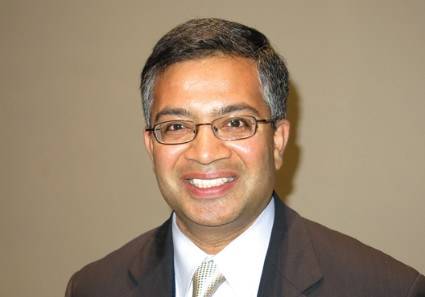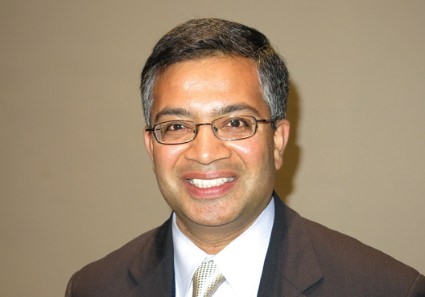User login
SAN FRANCISCO – Physicians and midlevel health care providers saw comparable types of patients with diabetes in the Veterans Affairs health care system and helped patients achieve comparable changes in hemoglobin A1c levels, a study of 19,238 health care providers found.
"At the time of diagnosis of diabetes and during 4 years of follow-up care, nurse practitioners and physician assistants have patient populations that are comparable to those of physicians, and their diabetes management is as good as that provided by physicians," Dr. Lawrence S. Phillips said at the annual scientific sessions of the American Diabetes Association.
Diabetes affects more than 20% of patients in the VA system, which is the largest employer of nurse practitioners and physician assistants in the country, he said. Dr. Phillips and his associates analyzed VA data to identify patients who saw a physician, nurse practitioner, or physician assistant for more than 50% of health care visits since a new diagnosis of diabetes in 2008-2012.
Average HbA1c levels at the time of diabetes diagnosis, at the initiation of medications, and during follow-up years did not differ significantly between provider groups after patient characteristics were adjusted for, reported Dr. Phillips, professor of medicine at Emory University, Atlanta. Baseline HbA1c levels were 7.18%, 7.14%, and 7.20% with nurse practitioners, physician assistants, and physicians, respectively, and dropped to 6.75%, 6.75%, and 6.78% by 2012.
Patient demographics were similar between provider groups. Their mean age was roughly 69 years, about 95% were male, and their mean body mass index was about 32.4 kg/m2. The cohort seen by physicians had a smaller percentage of white patients (77%) than did the cohort seen by physician assistants (81%).
Patient comorbidity levels, as measured by the Charlson Comorbidity Index, were the same in each provider group (a score of 1 in each group). The proportion of patients on any diabetes therapy was similar between groups: 81% with physicians, 80% with nurse practitioners, and 79% with physician assistants.
A significantly smaller proportion of patients seeing physician assistants were on insulin (12%), compared with those seeing physicians (15%) or nurse practitioners (14%), Dr. Phillips reported. Physician assistants also referred a significantly smaller proportion of patients to diabetes specialists (5%), compared with physicians (8%) or nurse practitioners (7%).
The findings surprised the investigators and suggested that the VA model of using midlevel providers might be broadly useful to help the U.S. meet demand for primary care providers, he said.
Dr. Phillips reported having financial associations with multiple pharmaceutical companies but none related to this study.
On Twitter @sherryboschert
This study defined provider type by whether a physician or midlevel practitioner saw the patient in 50% or more of the patient’s visits. But it could be that the VA system has appropriate and selective use of MD specialists, who guide the initiation of insulin and escalation of therapy, and then, appropriately, the midlevel providers deliver more education-related or lifestyle-related care. I think a little bit more understanding of who is doing what, not just where the majority of care is being conducted, is needed to fully understand this.
 |
|
We don’t live in a world where specialists can be delivering all of diabetes care. The numbers don’t add up. Where we need to go is figuring out how we can effectively use each of our provider types.
I would lean more toward this study being a first step in understanding. Are we talking about replacing or complementing physicians? Before we see more data, I would think that we still are in a complementing world, but we need to refine that.
Dr. Sanjeev N. Mehta of the Joslin Diabetes Center, Boston, gave these comments in an interview at the meeting. He reported having no financial disclosures.
This study defined provider type by whether a physician or midlevel practitioner saw the patient in 50% or more of the patient’s visits. But it could be that the VA system has appropriate and selective use of MD specialists, who guide the initiation of insulin and escalation of therapy, and then, appropriately, the midlevel providers deliver more education-related or lifestyle-related care. I think a little bit more understanding of who is doing what, not just where the majority of care is being conducted, is needed to fully understand this.
 |
|
We don’t live in a world where specialists can be delivering all of diabetes care. The numbers don’t add up. Where we need to go is figuring out how we can effectively use each of our provider types.
I would lean more toward this study being a first step in understanding. Are we talking about replacing or complementing physicians? Before we see more data, I would think that we still are in a complementing world, but we need to refine that.
Dr. Sanjeev N. Mehta of the Joslin Diabetes Center, Boston, gave these comments in an interview at the meeting. He reported having no financial disclosures.
This study defined provider type by whether a physician or midlevel practitioner saw the patient in 50% or more of the patient’s visits. But it could be that the VA system has appropriate and selective use of MD specialists, who guide the initiation of insulin and escalation of therapy, and then, appropriately, the midlevel providers deliver more education-related or lifestyle-related care. I think a little bit more understanding of who is doing what, not just where the majority of care is being conducted, is needed to fully understand this.
 |
|
We don’t live in a world where specialists can be delivering all of diabetes care. The numbers don’t add up. Where we need to go is figuring out how we can effectively use each of our provider types.
I would lean more toward this study being a first step in understanding. Are we talking about replacing or complementing physicians? Before we see more data, I would think that we still are in a complementing world, but we need to refine that.
Dr. Sanjeev N. Mehta of the Joslin Diabetes Center, Boston, gave these comments in an interview at the meeting. He reported having no financial disclosures.
SAN FRANCISCO – Physicians and midlevel health care providers saw comparable types of patients with diabetes in the Veterans Affairs health care system and helped patients achieve comparable changes in hemoglobin A1c levels, a study of 19,238 health care providers found.
"At the time of diagnosis of diabetes and during 4 years of follow-up care, nurse practitioners and physician assistants have patient populations that are comparable to those of physicians, and their diabetes management is as good as that provided by physicians," Dr. Lawrence S. Phillips said at the annual scientific sessions of the American Diabetes Association.
Diabetes affects more than 20% of patients in the VA system, which is the largest employer of nurse practitioners and physician assistants in the country, he said. Dr. Phillips and his associates analyzed VA data to identify patients who saw a physician, nurse practitioner, or physician assistant for more than 50% of health care visits since a new diagnosis of diabetes in 2008-2012.
Average HbA1c levels at the time of diabetes diagnosis, at the initiation of medications, and during follow-up years did not differ significantly between provider groups after patient characteristics were adjusted for, reported Dr. Phillips, professor of medicine at Emory University, Atlanta. Baseline HbA1c levels were 7.18%, 7.14%, and 7.20% with nurse practitioners, physician assistants, and physicians, respectively, and dropped to 6.75%, 6.75%, and 6.78% by 2012.
Patient demographics were similar between provider groups. Their mean age was roughly 69 years, about 95% were male, and their mean body mass index was about 32.4 kg/m2. The cohort seen by physicians had a smaller percentage of white patients (77%) than did the cohort seen by physician assistants (81%).
Patient comorbidity levels, as measured by the Charlson Comorbidity Index, were the same in each provider group (a score of 1 in each group). The proportion of patients on any diabetes therapy was similar between groups: 81% with physicians, 80% with nurse practitioners, and 79% with physician assistants.
A significantly smaller proportion of patients seeing physician assistants were on insulin (12%), compared with those seeing physicians (15%) or nurse practitioners (14%), Dr. Phillips reported. Physician assistants also referred a significantly smaller proportion of patients to diabetes specialists (5%), compared with physicians (8%) or nurse practitioners (7%).
The findings surprised the investigators and suggested that the VA model of using midlevel providers might be broadly useful to help the U.S. meet demand for primary care providers, he said.
Dr. Phillips reported having financial associations with multiple pharmaceutical companies but none related to this study.
On Twitter @sherryboschert
SAN FRANCISCO – Physicians and midlevel health care providers saw comparable types of patients with diabetes in the Veterans Affairs health care system and helped patients achieve comparable changes in hemoglobin A1c levels, a study of 19,238 health care providers found.
"At the time of diagnosis of diabetes and during 4 years of follow-up care, nurse practitioners and physician assistants have patient populations that are comparable to those of physicians, and their diabetes management is as good as that provided by physicians," Dr. Lawrence S. Phillips said at the annual scientific sessions of the American Diabetes Association.
Diabetes affects more than 20% of patients in the VA system, which is the largest employer of nurse practitioners and physician assistants in the country, he said. Dr. Phillips and his associates analyzed VA data to identify patients who saw a physician, nurse practitioner, or physician assistant for more than 50% of health care visits since a new diagnosis of diabetes in 2008-2012.
Average HbA1c levels at the time of diabetes diagnosis, at the initiation of medications, and during follow-up years did not differ significantly between provider groups after patient characteristics were adjusted for, reported Dr. Phillips, professor of medicine at Emory University, Atlanta. Baseline HbA1c levels were 7.18%, 7.14%, and 7.20% with nurse practitioners, physician assistants, and physicians, respectively, and dropped to 6.75%, 6.75%, and 6.78% by 2012.
Patient demographics were similar between provider groups. Their mean age was roughly 69 years, about 95% were male, and their mean body mass index was about 32.4 kg/m2. The cohort seen by physicians had a smaller percentage of white patients (77%) than did the cohort seen by physician assistants (81%).
Patient comorbidity levels, as measured by the Charlson Comorbidity Index, were the same in each provider group (a score of 1 in each group). The proportion of patients on any diabetes therapy was similar between groups: 81% with physicians, 80% with nurse practitioners, and 79% with physician assistants.
A significantly smaller proportion of patients seeing physician assistants were on insulin (12%), compared with those seeing physicians (15%) or nurse practitioners (14%), Dr. Phillips reported. Physician assistants also referred a significantly smaller proportion of patients to diabetes specialists (5%), compared with physicians (8%) or nurse practitioners (7%).
The findings surprised the investigators and suggested that the VA model of using midlevel providers might be broadly useful to help the U.S. meet demand for primary care providers, he said.
Dr. Phillips reported having financial associations with multiple pharmaceutical companies but none related to this study.
On Twitter @sherryboschert
AT THE ADA ANNUAL SCIENTIFIC SESSIONS
Key clinical point: Patients who saw midlevel providers for most of their visits achieved HbA1c levels comparable with those of patients who saw primarily physicians.
Major finding: The characteristics and comorbidity levels of patients with diabetes, and their HbA1c levels after treatment, were similar among patients seen predominantly by physicians, nurse practitioners, or physician assistants.
Data source: A retrospective study of patients with diabetes seen by 19,238 physicians or midlevel providers in the VA health care system from 2008 to 2012.
Disclosures: Dr. Phillips reported having financial associations with multiple pharmaceutical companies but none related to this study.
